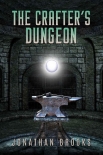The Dungeon Fairy: A Dungeon Core Escapade (The Hapless Dungeon Fairy Book 1) Jonathan Brooks (the dot read aloud TXT) 📖

- Author: Jonathan Brooks
Book online «The Dungeon Fairy: A Dungeon Core Escapade (The Hapless Dungeon Fairy Book 1) Jonathan Brooks (the dot read aloud TXT) 📖». Author Jonathan Brooks
Another week went by as she created creatures of different species and positioned them in her dungeon, and then she spent some time placing traps. Those traps, unlike her small Confusion ones that she had used to gain CIPs, were much stronger, if not necessarily deadlier. Tacca had Enchantment traps that produced enormous rage in its victims, ones that produced fear, and even one that caused anyone caught in the trap to become significantly slower. She also had some deadlier pit traps in a room, even though they were ridiculously expensive in terms of Dungeon Force.
Soil-covered Pit Trap
The Soil-covered Pit Trap can be placed on the floor of the dungeon, must be covered by soil, and is triggered by proximity. Once triggered, the soil collapses and victims plunge into a deep pit lined with small stone spikes. All traps can be disabled with high enough Disarm Trap skills.
Cost: 950 DF
Replacement Cost: 475 DF
Creation Time: 2 Hours
Disarm Trap Resistance: 2
Activation Range: 4.0ft X 4.0ft X 20.0ft
Trigger Proximity: 0.2 ft
Strength: 8.0
Duration: N/A
Resistance Category: Physical
Special Effects: Causes physical damage from the fall, as well as potential physical damage from impalement upon stone spikes
If Tacca hadn’t increased her Core Improvement Level, she wouldn’t have even been able to afford to create a simple 4ft-wide, 4ft-long, and 20ft-deep pit trap with spikes on the bottom. As it was, 950 DF was a serious drain on her maximum of 1,500; normal Dungeon Cores wouldn’t have to worry about that, but she was almost hesitant to even try it because of the risk of cracking. What she did to prepare for it, though, was to wait an hour before using that much Dungeon Force and an hour afterwards before using any more…and that seemed to work. There was a strain on her Core that she felt deep down, but by using her Force cautiously like that, she prevented any more damage from occurring to her spherical form.
When she was all done with construction, Environmental Object placement, and creature and trap production, there was one last thing to do: rewards. While Raiders benefitted in their own way from killing creatures – and even surviving/disarming traps, or so she’d learned – many of them wanted tangible “rewards”. At the moment, she only had access to rewards in Reward Tier 1 – which was basically only copper and silver coins, crude iron weapons, ragged leather armor, and a few basic cloth pieces of clothing. It was suitable for a dungeon just starting out, though, so it would work for now.
Reward Tier 1
Reward
Cost
Copper Coin
1 DF
Silver Coin
10 DF
Rusty Iron Dagger
20 DF
Rusty Iron Shortsword
20 DF
Rusty Iron Mace
20 DF
Rusty Iron Axe
20 DF
Flimsy Pine Bow
20 DF
Cracked Maple Staff
20 DF
Small Battered Oak Shield
15 DF
Ragged Leather Chestpiece
15 DF
Ragged Leather Leggings
15 DF
Ragged Leather Vambraces
15 DF
Ragged Leather Boots
15 DF
Ragged Leather Helmet
15 DF
Ragged Leather Gloves
15 DF
Basic Cloth Robe
10 DF
Basic Cloth Tunic
10 DF
Basic Cloth Trousers
10 DF
Tacca thought about Darlene, who had likely spent most of her CIPs on raising her Reward Tier to much higher levels than she probably should’ve. Thinking about her actual dungeon, which was fairly plain and only barely larger than Tacca’s own, she realized that the other Core had likely spent almost all of her available Points on unlocking more rewards; in fact, there were even a few Special Characteristics that related to rewards as well, so it was entirely possible she had those as well. Even if Tacca hadn’t seen the folly of having entirely too rich of rewards in a relatively weaker dungeon herself, she knew enough common sense that having access to that kind of thing – and using them – was a very poor idea.
To assign a reward to a creature – or eventually she would be able to acquire a chest to hold additional rewards – all she had to do was concentrate on it and choose one of her rewards. When the creature was killed, the reward would automatically appear once it disappeared, even if it was larger than the creature itself; for instance, if she had a Rusty Iron Shortsword as a reward for a slain fox, the weapon was actually longer than the length of the creature – but that didn’t matter for the reward rules. There was technically no limit to how many rewards she could assign to each creature, though a balance of not too much and not too little was important to achieve.
Once the reward was in place, it would automatically add to the cost of replacement of the creature once it was killed – if it was set up for automatic replacement, of course. So, for example, a Level 1 Root Fox that cost 5 DF to bring back could have 2 copper coins as a reward and would therefore require 7 DF to fully replace. Luckily, all of that was easily automated so she didn’t have to remember how much she put with each creature, as that could get complicated after a while. That automation – she realized – was also what led to many older Dungeon Cores to become complacent; when they had their dungeon set up the way they wanted, they really didn’t have to do anything to maintain it. They just reaped the rewards for a long time, probably refusing to do any more work to expand and change difficulties and make it fresh, especially if everything was operating just fine already.
The automation was beneficial for now, though, because she wasn’t planning on changing things up too much in the near future. Most of the creatures throughout her rooms she set up to give out a few copper coins; her deadlier ones, however – including what she had prepared in the





Comments (0)